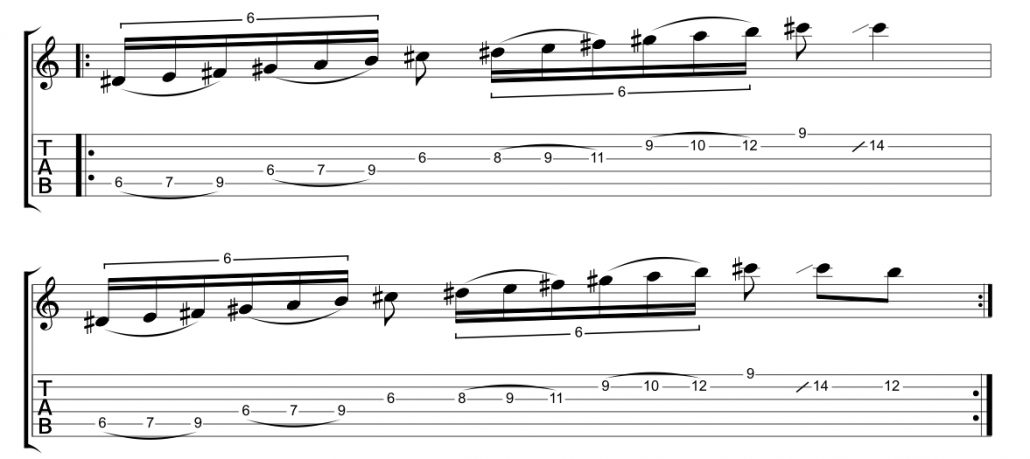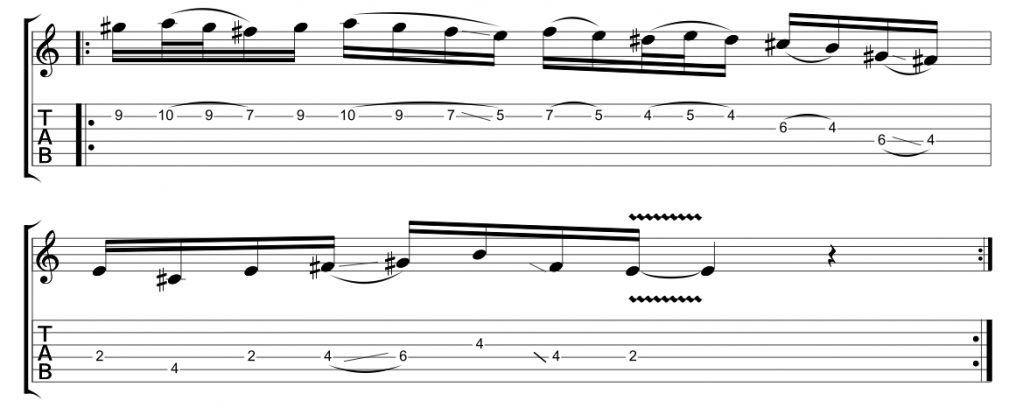Creating Memorable Solos With Legato
In today’s lesson, we examine the use of legato in creating memorable guitar solos. From simply adding hammer-ons and pull-offs to the blues scale, to complex 3-note-per-string natural minor ideas this lesson will help you add the smooth, free-flowing sound of legato into your soloing.
Melodic Legato Example 1 – C# Blues Scale
The simplest form of legato playing is using hammer-ons and pull-offs. In the late 1960s / early 1970s, guitarists like Jimmy Page and Brian May used this technique to add speed to their primarily pentatonic licks. Example one uses the C# blues scale in position 1 and uses a combination of hammer-ons and pull-offs to create a speedy lick. Although the full speed example is around 100bpm, I recommend practicing this lick slowly at around 70bpm before speeding it up.
Melodic Bends Example 2 – C# Natural Minor 3 Note Per String
Modern day rock guitarists like Joe Satriani and Steve Vai pushed the boundaries of legato playing by using 3 notes per string instead of the traditional 2 notes per string seen in example 1. Example 2 uses the C# natural minor scale with three notes applied across multiple strings. Remember that your 3rd and 4th fingers are weaker than the 1st and 2nd, but in legato playing the ultimate aim is to have every finger able to hammer and pull each note equally. See how I create this even sound in the YouTube video.
Melodic Bends Example 3 – Adding Slides To Legato
Example 3 adds slides to a legato pattern to create a free flowing C# natural minor lick. By adding slides to a legato pattern, you can slide between each scale shape keeping the fluid legato sound.
Of course, all these ideas can also be used with the CAGED system too! If you don’t know how the CAGED system is essential knowledge for guitarists, you should!
Recommended listening
For classic legato guitar licks, I recommend buying the album “Best Of – Joe Satriani.” My favourite track on that album being “Flying In A Blue Dream.”
Subscribe on Youtube
Make sure you log on and subscribe to our new YouTube Channel, dedicated to bringing you the finest free guitar lessons.
Guitar Lesson Video Transcription
Hi YouTube, Simon here once again for the amazing Fundamental Changes. Today we’re going to look at some legato techniques to incorporate into your memorable guitar solos. Let’s go and have a look at 3 examples of that, next.
[guitar playing]
Today’s examples are all legato-based, meaning that we’re not going to be using quite so much plectrum, really. We’re going to be hammering-on and pulling off. Now, the simple terms of this are hammering-on and pulling off, as I just said, but modern day legato uses multiple fingers to do that.
Guys like Satriani and Steve Vai, they’ve made a massive leap forward in legato techniques in the rock world, but it started off back in the late 60’s and 70’ with guys using pentatonic patterns and blues patterns, hammering-on and pulling off to create speed that they couldn’t create with a plectrum.
Example 1 here uses the C sharp blues scale. Once again, we’re using the same backing track we’ve been using throughout the last few weeks. If you don’t know what that is, go and have a look at some of the previous lessons here.
This example using the C sharp blues scale up around between the 9th and the 12th frets, the scale diagram will be included in the article. Once again, start off slowly, follow my finger patterns that you see in the slowed down example, and let’s have a look at Example 2.
[guitar playing]
I wanted to introduce multiple finger hammering-on today. This example is around a C sharp natural minor scale, and using 3 notes per string (which is a classic legato technique), you can go on from this to build as many patterns as you like going between the different fingers.
But, what I want you to do today is just get used to using multiple fingers: hammer, pick, hammer, hammer, pick, hammer, hammer, pick, pick, hammer, hammer, pick, hammer, hammer, pick. Of course, the observant among you will realize you can of course practice the reverse of that, which we pick, pull off, pull off – just trying to work this out in my mind – pick, pull off, pull off, all the way through these little 3 note per string examples.
I haven’t tabbed that out or done that as an example, but that would work brilliantly well. Just start at the top note, and then pick, pull off, pull off, pick, pull off, pull off, all the way back down to the 6th fret here, which is your D sharp. But then, you want to resolve to the C sharp notes over this backing track, which would be the 4th fret. So, multiple string legato, really, really fun, but you need more notes on the string than the normal pentatonic shapes, so that’s why we’ve included this C sharp Aeolian or C sharp natural minor scale.
Hope you enjoyed that one; let’s look at Example 3.
[guitar playing]
One of the main reasons I like legato is it has a really fluid sound. It can sound incredibly melodic, as opposed to the slightly harsher alternate picking, which of course has its’ place as well, but this example here demonstrates again around the C sharp natural minor scale. Look at the full neck diagram I included in the article if you’re struggling to see these shapes.
Once again, this time we’re using little slides to get through little multiple positions of this shape. When you combine legato with slides, you’ve got an even smoother, more free-flowing type of sound, because you can have 1 shape, and then slide into another shape, and you’re off, and then you’re off again, etc., etc., etc.
You can work on moving between each shape, and then sliding into the next shape, and then back and forth. This one will take a little bit more practice because there’s very few pick strokes, but if you’re struggling with that, add in a few more. It’s not an exact science, what I’ve written here, these licks today. Just some nice legato-ey ideas over this backing track we’ve been looking at.
I hope you’ve had some fun with these, write your own examples using the blues scale, which will be tabbed out four neck diagram and the C sharp natural minor, which will also be put in the neck diagram.
If you’ve got any comments, if you want to do your own version of some of these licks, please just post it and tag us in this. I watch all of them, and I love hearing from you. It’s a real pleasure I get to teach some of you.
I hope you’ve got something from it, and I’ll see you next time. Take care.
Hi everyone, thanks for watching these legato techniques in creating memorable solos, I hope you got something from it. Please subscribe here. Subscribe to my YouTube channel SDP guitar and go and check out Joseph’s books on YouTube, Fundamental Changes, and his website.
Take care, see you soon.
“The artists you work with, and the quality of your work speaks for itself.”
Tommy Emmanuel
© Copyright Fundamental Changes Ltd 2025
No.6 The Pound, Ampney Crucis, England, GL7 5SA






